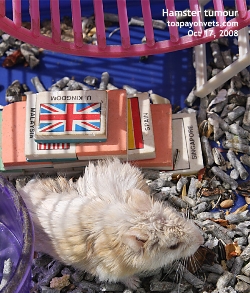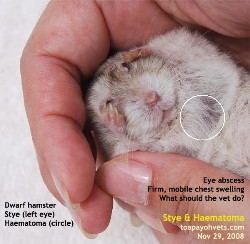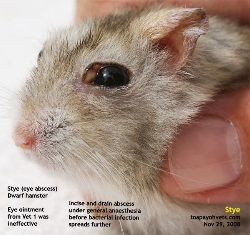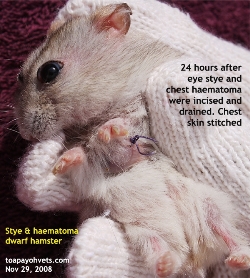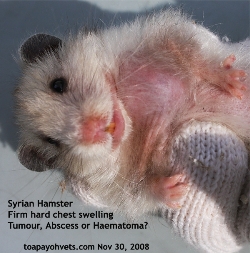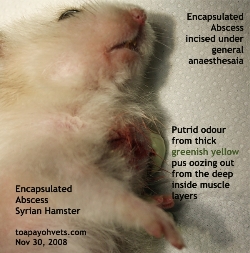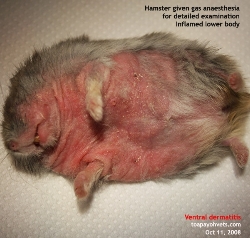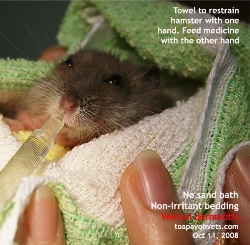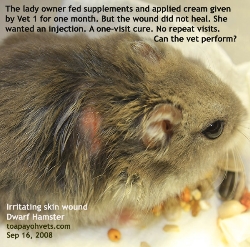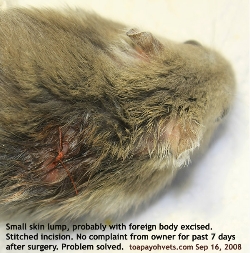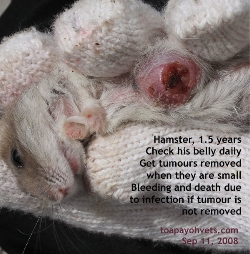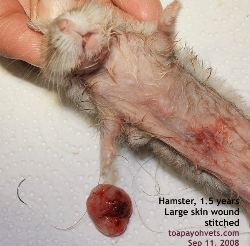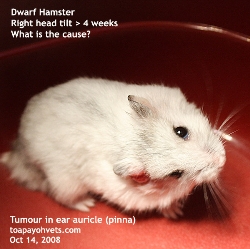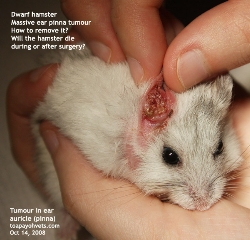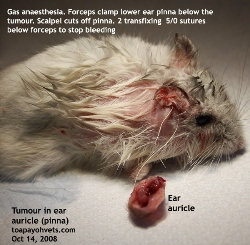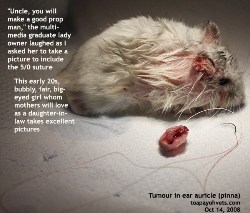WHAT TO EXPECT.
The veterinarian removes the tumours/lumps in the hamster skin. Usually the hamster needs to be anaesthesized if the tumour/swelling is large.
WHAT TO DO BEFORE.
Make appointment 6254-3326, 9668-6469 for
surgery. The pet must be healthy and not obese
(if possible). He is active and has an
excellent appetite. Clean up the hamster if
possible and/or let him have a sand bath 2 days
before surgery. Bring the pet to the surgery
at 9 a.m. Bring along his carrier cage, water
bottle, exercise wheel and food. No starvation
12 hours prior to anaesthesia is necessary in
the hamster. The hamster may spit out his food
stored in his cheek pouch at the end of
anaesthesia.
WHAT TO DO DURING.
The hamster is put into an anaesthetic
container. General anaesthesia using
isoflurane gas is piped into the container.
When the hamster is anaesthesized, he is taken
out and put on the operating table. In some
cases, the hamster is sedated prior to
anaesthesia.
The skin tumours are cut off. Swellings with blood (haematoma) or pus (encapsulated abscesses) are incised and drained. Stitching may be done but the hamster usually bites them off. As much blood is cleaned off as possible.
WHAT TO DO AFTER.
The owner takes the hamster home at around 5
p.m or after a few days. Make sure that the
hamster is kept in a clean cage with towel
papers for at least 7- 14 days till the wound
heals. Check the wound daily for signs of
itchiness or infection. Use a facial cotton or
tissue soaked in clean warm water and wipe
away any blood clots. Replace the towel papers
as bedding daily.
The stitches on the skin, if not bitten off by
the hamster, will dissolve after 14 - 30 days.
There is no need to return to the surgery for
stitch removal. Consult the vet promptly if
the hamster is not eating or active or he
keeps licking the wound from day 3. The phone
number is 9668-6469.
No sand bath or sharp pieces of bedding for
the next 30 days to let the wound heal in a
clean environment. Give medicine as
instructed.
POSTPONEMENT OF SURGERY.
If the hamster is not in a good condition, the
hamster is warded for observation and
treatment for 1-3 days before surgery is done.
ESTIMATED COSTS
Gas anaesthesia $50.00
Surgery $20 to $150 depending on the size of
the tumour and the time taken
Total costs are from $70.00 to $200.00.
Warding fees at the surgery: $2.00 per day.
ANAESTHETIC RISKS
No professional vet can guarantee that
there is no risks in anaesthesia of your
hamster. If the hamster is in good body
condition, the risks are minimal.
ALTERNATIVE TO SURGERY
A growing hard tumour becomes too heavy
for the hamster. The tumour becomes injured as
the hamster tries to rub it away. There will
be infection all over the skin (cellulitis). After some time, the hamster
stops eating, becomes thinner and dies.
There are still some Singapore parents of the
older generation who will say that it is
cheaper just to buy a replacement hamster. A
new dwarf hamster costs $5.00 -$10.00 and a
Syrian hamster costs $18.00 usually.
Why pay so much for the veterinary surgery?
The dependent children have cared for the
hamster for the past year and will want the
pet who is now family, to be treated. They are
not interested in the pragmatic aspect of
getting a new pet and will just ignore the
recommendation. The tumour just grows bigger
and bigger.
It will be much cheaper and safer for the hamster to get the tumour removed by the vet when it is small. Estimated cost including anaesthesia and consultation is $70.00.
 TOA
PAYOH VETS
TOA
PAYOH VETS